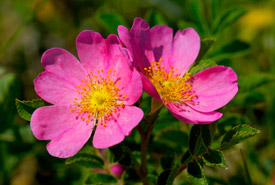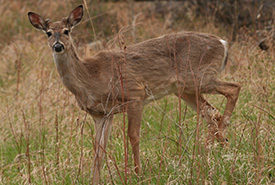Going head to head with the prairie rose

Prairie rose (Photo by Karol Dabbs)
I cannot kill this dang plant growing in my garden!
Emotionally I can’t kill it, because it means something to me, and literally, because I accidentally tried and it didn’t die. This hardy little number is the prairie rose, and it’s a darn prairie hero. But in this garden, it’s like a weed. It’s the good guy in the bar brawl that gets kicked and stomped on. Just when you think it’s dead — no leaves showing — boom!
Dark green leaves, thickly prickled stem and, eventually, delicate pink flowers — that’s what’s happening in my garden right now. In and amongst the tomatoes, a bushy little reminder of what was.
The small town I live in used to sit in the heart of the fescue prairie, but there’s not much of it left now. This is because most of the fescue prairie has been turned into wheat fields, yard sites or, in my case, a garden.

Young mule deer (Photo by NCC)
The cultivation that most of Saskatchewan’s communities are based on generally does a pretty thorough job of killing all native plants. But not too many native species that make up fescue prairie are as hardy as my rose. The aster near the long-jump pit, the prairie sage found on the big open grassy spot and the pussy toes in the cemetery are pretty much it for native plants. It’s tough for those plants to hang on, and most can’t after being cultivated, sprayed, trampled on and, quite frankly, forgotten — but more on that later. And once that earth has been scorched to grow wheat, it’s even tougher to get it back to prairie. Almost impossible.
Here’s the forgotten part: near the end of the school year, my daughter’s Grade 2 class presented an hour of poetry to the parents and grandparents squeezed into the moulded plastic seats laid out in the library. Poems were read aloud about leaves, beaches, trees, video games, pets and snakes. Exactly what you’d expect. Then there was a parade of the cutest kids you’ve ever seen displaying hand-drawn pictures, with a declaration of why they loved the forests, oceans, mountains and wheat fields of Canada.
What wasn’t mentioned were the swaths of native prairie I get to wander through. None of the knolls and depressions. No wetlands filled with cattails and ducks. No springy mule deer, gangly legged moose or bobbing grey partridge families. Why is that? My daughter knows what I do…sort of. About 20 per cent of Saskatchewan’s prairie is still intact. Even though a lot of it is in the south, her classmates and their families would have driven by some prairie potholes on their way to the oceans, forests and mountains they showed their love for. My favourite landscape was simply not on their radar.
It’s tough getting native plants to grow back. Once someone’s worked hard to blacken a field to grow wheat, putting it back to native plants is really hard. Finding the right seeds and plants, controlling weeds, timing planting to get them to take and then planning how to keep adding back the dozens and dozens of species it would have had before is a lifelong task. If all native plants were as tenacious as the rose growing in my tomato patch, prairie restoration would be a snap.


